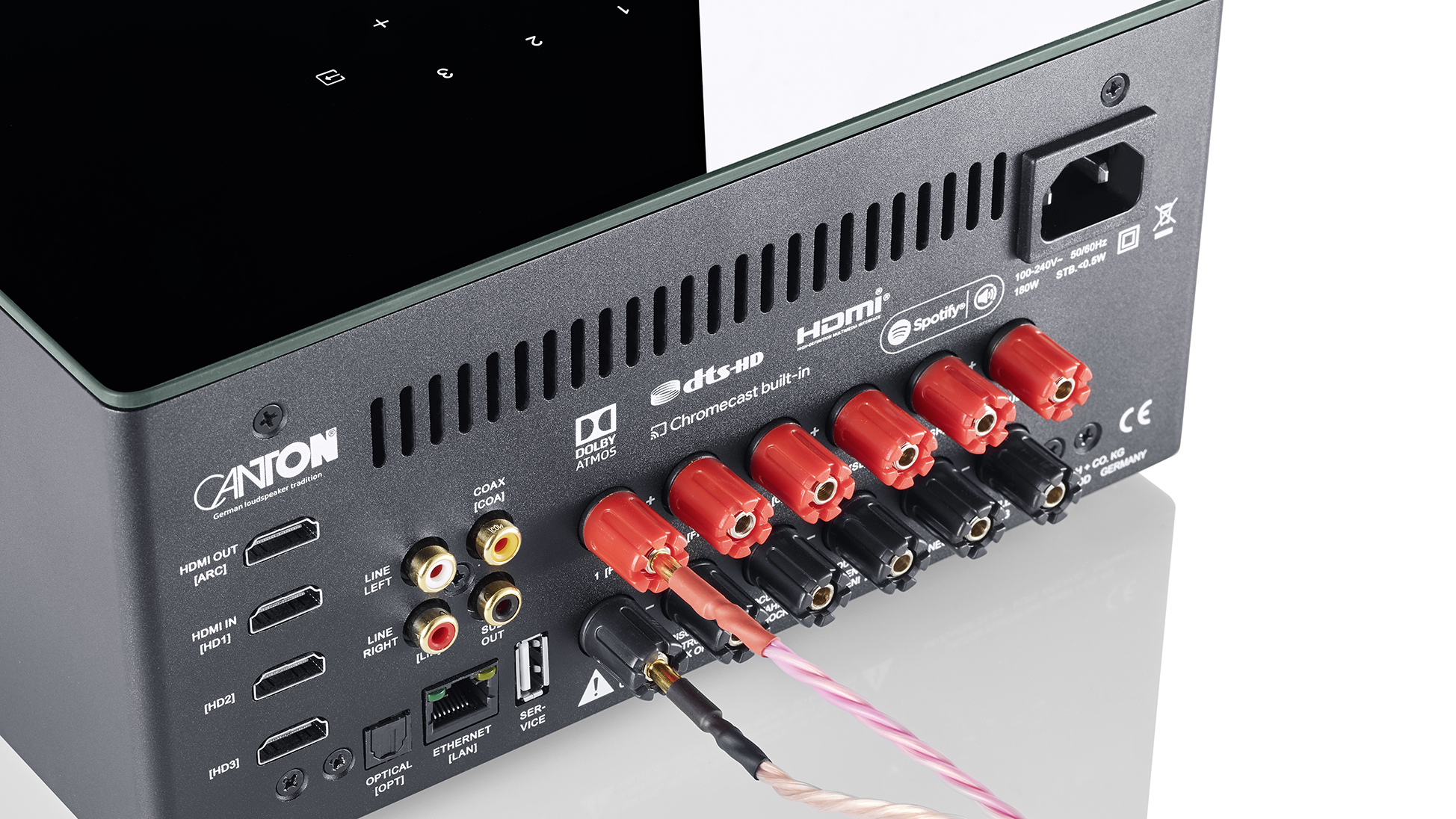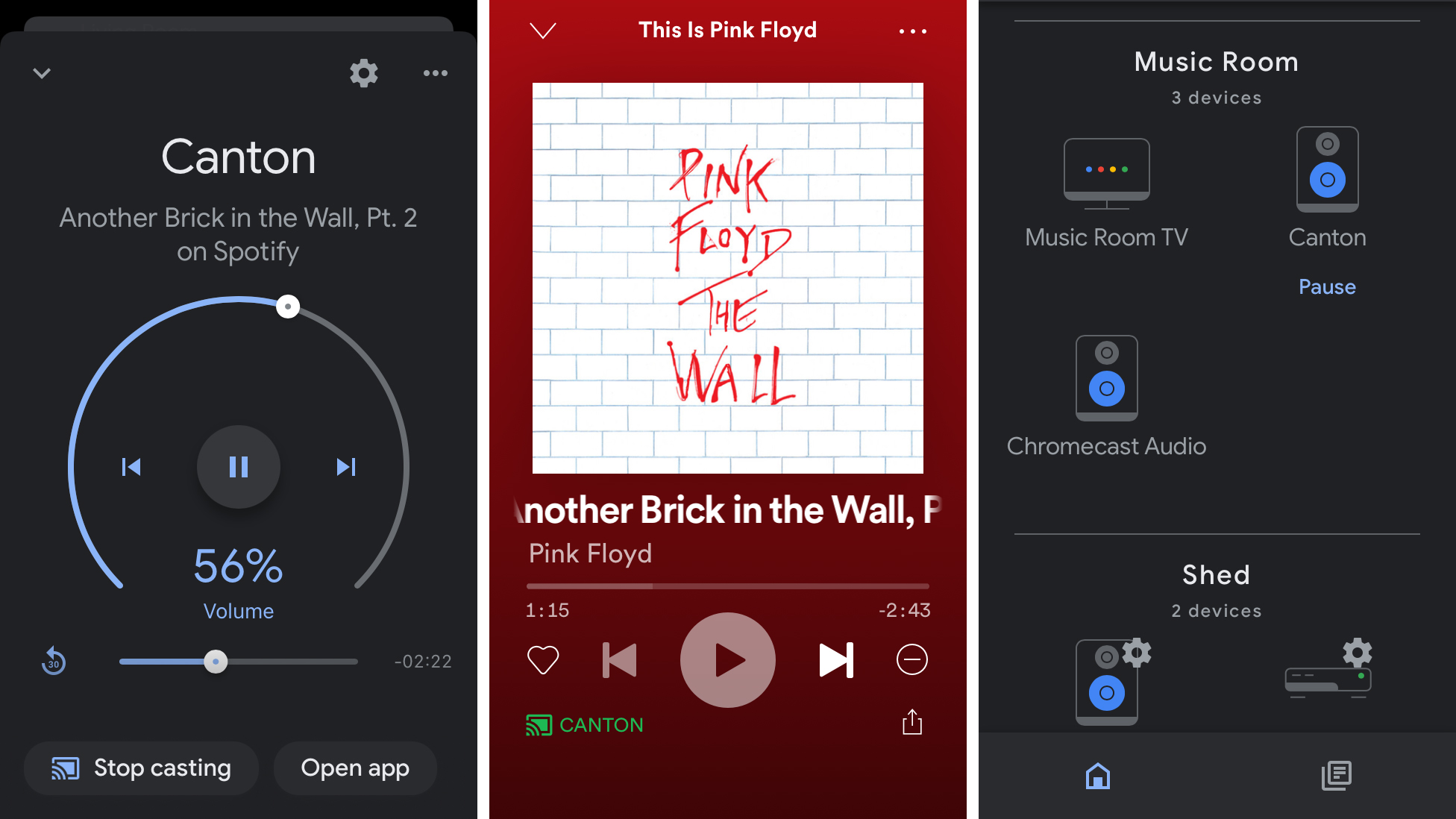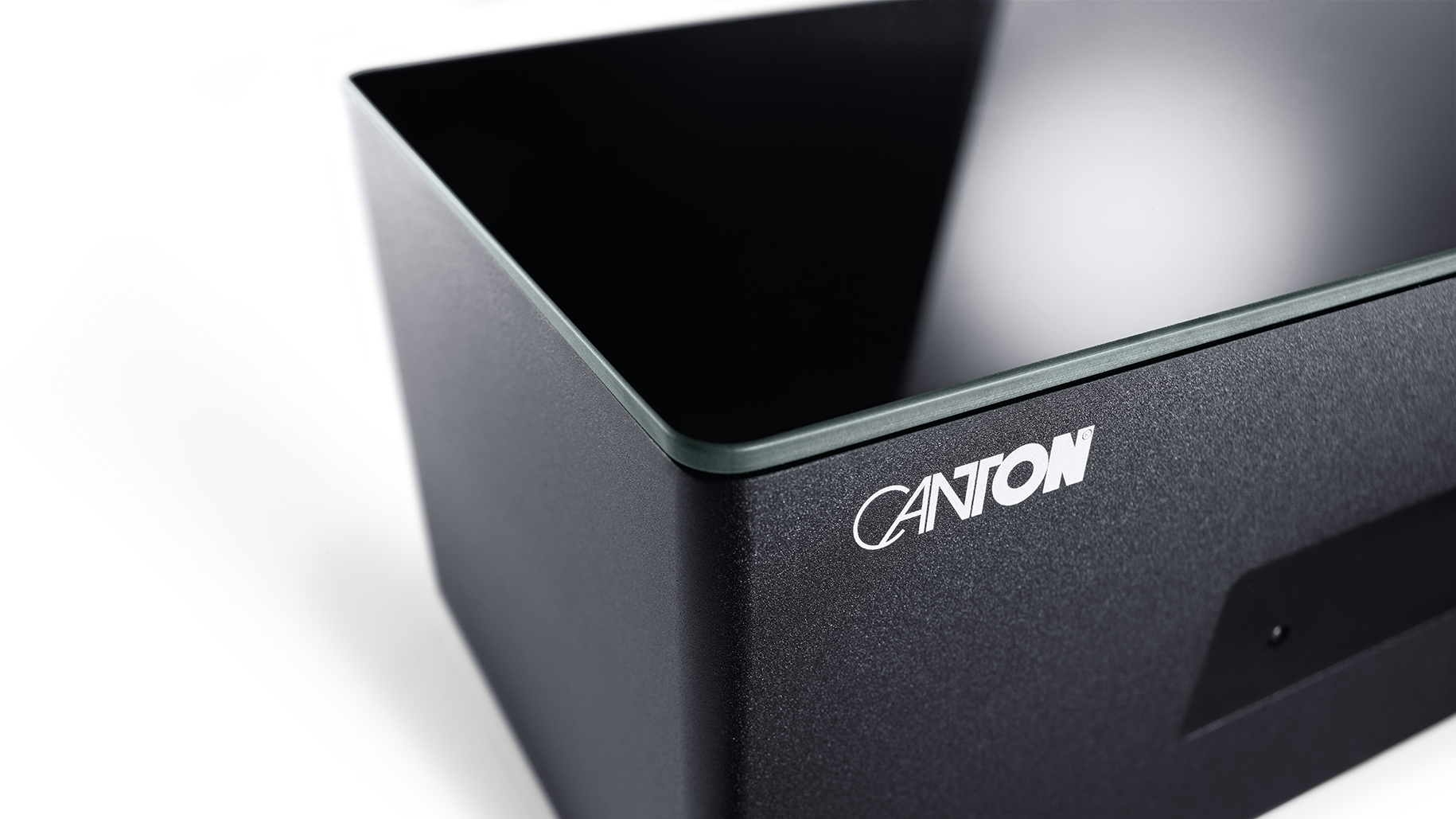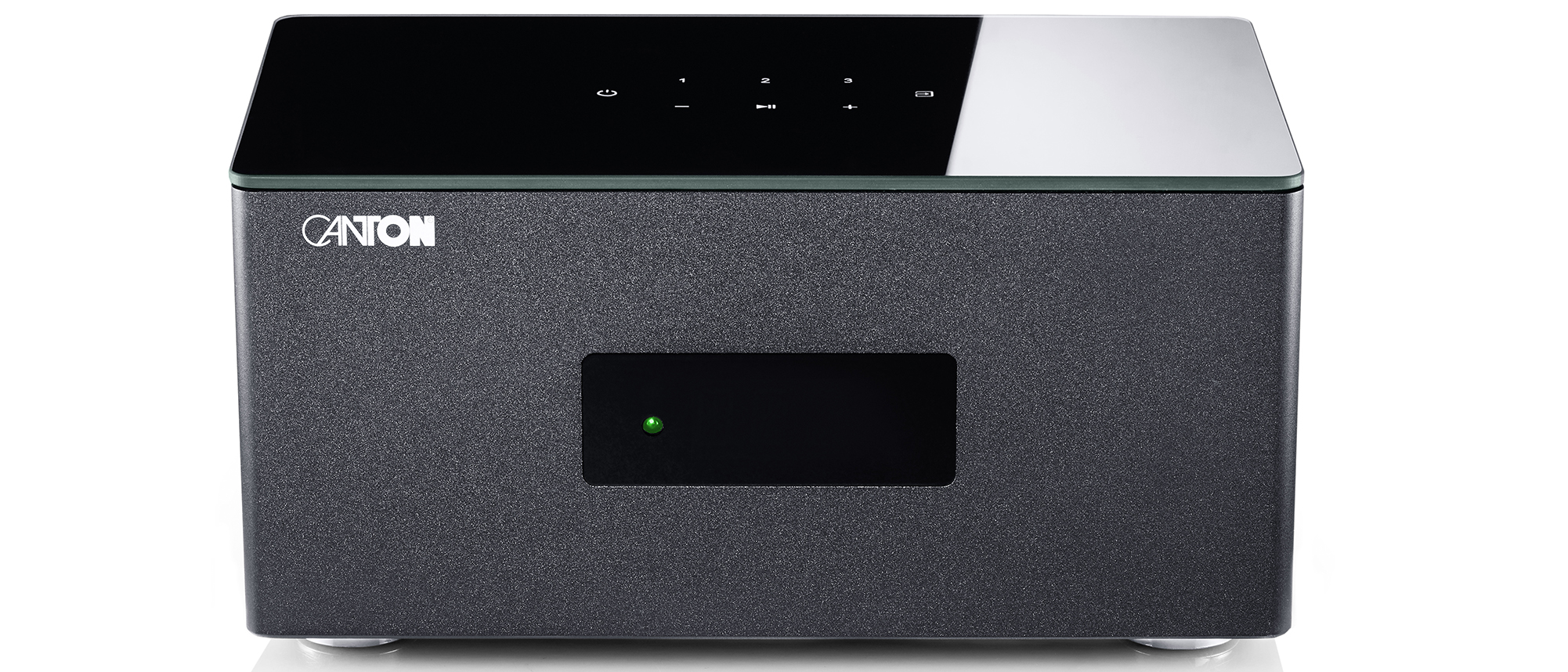Sound+Image Verdict
The Smart Amp 5.1 from Canton proves that you can get massive surround sound without the need for a massive and unsightly box. It offers terrific audio performance in its surround capacities and, beyond its physical 5.1 outputs, it can also expand to up to eight Canton Active speakers when connected wirelessly.
Pros
- +
Great surround performance
- +
Expandable with Canton speakers
- +
Versatile manual set-up
- +
Marvellously compact
Cons
- -
Limited inputs
- -
No pre-outs/headphone out
- -
Some issues with sample unit
Why you can trust What Hi-Fi?

This review originally appeared in Sound+Image magazine, one of What Hi-Fi?’s Australian sister publications. Click here for more information on Sound+Image, including digital editions and details on how you can subscribe.
AV receivers have always been large components. Inside they need the room for five or more amplifiers, each requiring enough space into which they can ventilate heat. Outside, meanwhile, their rear panels dazzle with an often bewildering array of rear-panel socketry catering to audio and video connections both modern and legacy.
To accommodate all this, and to do their job, then, home cinema receivers and amplifiers have always been full-width, double-height products that inevitably dominate an equipment rack.
And yet we’ve long wondered if this was really necessary. HDMI has simplified AV connections, using one plug where five were once necessary. Meanwhile the rise of efficient Class-D amplification has reduced if not entirely removed the problem of heat generation by multiple amplifiers.
So we were delighted to discover Canton’s Smart 5.1, which is a five-channel AV amplifier small enough almost to tuck away at the back of a shelf. It’s a radical shift from the physicality of other brands, even those like, say, Onkyo, which have managed to reduce the height of receivers closer to that of a conventional (large) stereo amplifier. But nothing like this. Canton’s box is just 24.5cm wide and 12cm high and weighs just 2.6kg.
So the question then becomes whether you give anything away in terms of performance and facilities to enjoy such a compact solution?
Equipment
Canton is celebrating 50 years in 2022, and over that half century the German company has become best known for its speakers. The most recent pair we looked at were the A 45 speakers, AU$6000 floorstanders with exotic ceramic tweeters and aluminium-ceramic tungsten cones. And Canton’s models rise high to the Reference K1, priced a dollar short of AU$45,000.
Canton always aimed to deliver budget-friendly designs as well as high-end, ever since its four hi-fi enthusiast founders set up in a former village school near Frankfurt in 1972, stating the ambitious goal of producing the best loudspeaker for every taste and every budget.
The latest hi-fi, home cinema and tech news, reviews, buying advice and deals, direct to your inbox.
While this indeed led to all manner of speakers being on the books of Canton today, the company diversified into electronics early on, with an early stereo receiver and high-quality preamp within its first decade.
More recently it has been developing a ‘Smart’ range combining both electronics and active speakers. And this is important in order to understand the full capabilities of this Smart 5.1 receiver.
While it is limited to 5.1-channel output in terms of powering passive speakers (via six sets of speaker terminals, including one unusual pair to drive a passive subwoofer), you can add further Canton Smart active speakers wirelessly – up to eight of them, indeed, including height speakers to enjoy the full possibilities of the unit’s Dolby Atmos processing. In this way it can deliver up to 7.1.2, or 5.1.4.
That level of wireless delivery represents a huge hidden extra, worth bearing in mind when reading this review, given that we didn’t have any Canton Smart speakers to try, so all our listening was kept to a maximum of 5.1.

We simply connected our front and surround speakers to the Canton’s solid if necessarily tightly-spaced binding posts – banana plugs for our front threesome, and bare wire to our rears. A subwoofer can connect either via the final set of speaker-level outputs or, as we did, at line-level from an RCA out.
The inputs are a little limited, partly by rear-panel space, compared with more bulky AV receivers. The main HDMI output includes ARC (the Audio Return Channel) to allow playback of audio from your TV, noting only that this is ARC not eARC, so some TVs may limit their output to stereo, while others will allow passthrough of 5.1 soundtracks, but certainly not Dolby Atmos and DTS:X from TV streaming services, say.
In addition there are three HDMI inputs to the rear, which display on the Canton’s LED front-panel display as ‘BDP’, ‘SAT’ and ‘PS’. In the menus you can change these to some other two-letter and three-letter options, though not to how the HDMI inputs are labelled on the rear panel itself, which is simply HD1, HD2 and HD3 — far better default labels, really.
Also renamable in this way are the audio inputs, which comprise a fairly minimal
single analogue RCA pair, one optical digital and one coaxial digital. There’s no USB connection other than a slot for servicing only, while the only other physical sockets
are for Ethernet networking, and power.
But there is also Bluetooth and Chromecast for wireless streaming. No advanced codecs are specified for the Bluetooth, but Chromecast can handle full CD quality and potentially above, to the 24-bit/96kHz for which the other digital inputs are specified.

There’s no app for the Canton amp itself, but it can operate within the Google Home app – indeed that’s what you have to use to connect it to your wireless network if you’re not giving it Ethernet.
Either of these network connections should then deliver automatic firmware updates when the unit is in standby; the front LED flashes green and red as it does (we never saw this happening, but our MCU firmware showed as 2.062, higher than Canton’s listed latest of 2.046).
Control
Rather pleasingly the Smart 5.1 amplifier does not come with a massive remote wand festooned with bewildering buttons, as is common with so many AV receivers, but instead with a remarkably small remote control which has been so impressively minimised that you wonder why other manufacturers don’t do something similar.
Indeed it was this remote which first endeared us to the whole product – it is so very solid and nicely weighty, with a curved cutout underneath which serves no apparent purpose other than making it rather pleasant to hold. German design in action!

At first we regulary mixed up the ‘source change’ up and down arrows with the ‘volume change’ + and ‘–’ buttons, but once past that initial confusion we became immensely fond of the remote control’s simplicity and ease of use.
This is just as well, given no app of its own to control it, other than Google Home, nor a browser-based interface for getting into settings. There is an on-screen display overlaying the signal sent to your TV, but this had problems on our sample; it was very faint and had half the letters missing, so the menus appeared as complete gobbledegook, at least until we realised it had also defaulted to German (with half the letters missing).
That left us accessing all its settings – and there are a lot of settings – using the simple remote control and the front-panel display, which is limited to displaying just those three large alphanumeric characters.
Either way, to get the best from this amplifier, you will need the full instruction manual kept to hand while you proceed through the many key settings and tweakable options – there are, if we count correctly, no fewer than 43 sub-menus available, with multiple further menus within most of them. On Canton’s website there’s a two-page summary of these (called Menu Structure), which might be handy to print out and keep in a nearby drawer.
There’s one last way to control the amp which you may miss – buttons on the glassy top surface for volume, play/pause, power and input channel, plus the three presets.
Performance
But when we originally set up the Smart 5.1, we touched almost no settings at all. It was replacing another AV receiver in our system, and we needed it working quickly, so we just plugged in our 5.1 speaker system, connected the HDMI ARC output to our TV, then our various sources to its HDMI inputs, and then we turned it on. We didn’t even connect it to our network; we just let it play.
It’s greatly to the Canton’s credit that all this worked just fine, except that the LED on the front panel flashed green continuously at us for the three weeks in which we used it like this, which was pretty annoying, but understandable, as it was prompting us to set it up properly using the Google Home app, or at least to plug in an Ethernet cable. (And we did later found a menu option that could disable this LED entirely.)
So despite the complexities of those internal menus and despite the possibility of a far more complex system using wireless speakers, it’s good to know that the Smart 5.1 amp does just plug and play, without any further intervention.
But to get its best, you need to delve a little deeper. Take the ‘Play Mode’ options, for example, which you can shuttle through using the button marked on the remote. In our initial usage, this button shuttled through three modes. ‘Stereo’ seemed self-explanatory, we thought. ‘Movie’ delivered surround soundtracks through the full system, and when given an Atmos source it reassuringly scrolled ‘Dolby Atmos’ across the three-character display. The third option, ‘Music’, we didn’t use much, but it was clearly upscaling stereo music to play through the full system.
After several weeks, however, the ‘Stereo’ option suddenly stopped working, for reasons we never did work out. It just went silent. That was when we discovered there are really not three but seven ‘play modes’ available, including modes labelled ‘Discrete’ and ‘Pure Direct’, which deliver signals with a minimum of processing.
Perusing the full-length manual online we discovered that the ‘Movie’ setting is there listed as delivering as “Virtual surround sound for movie playback”. So despite seeing ‘Atmos’ scrolling on the menu, had we been listening through a processed soundfield, rather than our preferred purity?
Yes we had. The ‘Movie’ mode incorporates a ‘3D’ soundfield which aims to deliver virtualised height from Atmos soundtracks, even without height speakers. The ‘Discrete’ mode turns this off (you can also turn it off or adjust the processing strength in other menu settings), while the ‘Pure Direct’ further prevents any upscaling of channels, should you have more than 5.1 speakers connected.
Anyway, to access these additional ‘play modes’, you have to manually turn each one on, within the menu structure. Thereafter we stuck with the ‘Pure Direct’ option for most listening, other than for experimentation; this mode also replaced our silent ‘Stereo’ issue, since it simply delivered stereo in stereo. We’re unsure why this desirable ‘Pure Direct’ option wouldn’t be one of Canton’s chosen default menu options.
And of course, we also went through the full set-up, including putting it on Wi-Fi through Google Home. Google’s app has the annoying habit of naming everything after the room it’s in, so the Canton ends up being called ‘Cinema speakers’, or ‘Lounge speakers’, which is invariably either wrong or at least confusing, given it’s not ‘speakers’ at all. But you can rename it later in the app.
You should also go into settings and enable Full Dynamic Range, which is off by default, and without which Chromecast will presumably add dynamic compression to your music.
It’s worth noting that through the Google Home app you can also achieve multiroom operation, playing via Chromecast or Spotify Connect to groups created within the Google Home app.

While there’s no auto-calibration system using a microphone here, all the required calibration adjustments are available manually. You can set speaker distances from the listening position to ensure accurate delay times, and set each speaker level.
You can re-allocate the speaker outputs, so that if you have Canton Smart speakers at the rear, say, you could use the two leftover amp channels for height. You can specify large or small (or Smart or none) for each speaker position to set crossover points to the subwoofer, and for that subwoofer you have the ability to adjust phase and again crossover frequencies. And there are useful built-in test tones to confirm what you’ve done.
There’s also more general EQ available from the remote control (treble, mid and bass), and there are three preset buttons on the remote under which you can store either a preferred set-up (selected input, volume, sound settings, gain adjustments) or a Spotify playlist. It’s good versatility.
As noted, even before we went through a manual calibration, we enjoyed several weeks of solid performance from the Smart 5.1. Now, with everything tightened up, the imaging and steering were even more impressive.
The Canton enabled our system to deliver some fine Atmos moments in episode one of Dr Brain, the AppleTV+ series: check the brain-sync sequence 45 minutes into the first episode for some wild surround field action, and from 51:40 for some nicely subtle atmospherics, which then move into some highly immersive rain effects. The Canton processed and delivered all this information beautifully, combining the dynamic ability to alarm with a subtlety that created a real sonic world from the best bits of sound design.
There’s just such a sequence around 1 hour 14 minutes into Disney’s new Encanto (Disney+, Atmos) when the family home collapses. It’s a full system workout, including subwoofer, and the Canton kept us deep in the action. We took the opportunity here to toggle between ‘Pure Direct’ and ‘Movie’, the latter with its Atmos ‘3D’ processing, which proved to be a dB or two louder, so hard to directly compare, but on the whole we’d say stick with Pure Direct – unless you’re using additional Smart speakers and wish to make use of channel upscaling.
There seemed no obvious shortage of power from the amplifiers, though we have little information on what form this amplification takes. Canton’s specifications say 600W total, being 6 × 100W (including the channel for a passive subwoofer), but without any mention of parameters – is this measured with 10% THD distortion allowed, as is common for AV gear in Europe, or with more hi-fi parameters e.g. 0.01% distortion? Is it Class-D, or some hybrid?
Canton doesn’t say, but we’d certainly guess Class-D from its performance with music. We played a good deal of the Atmos and surround music which has been delighting us of late. The Canton filled the room with such surround fare, whether streaming in Atmos from Tidal or Apple Music (from an AppleTV 4K plugged into the Canton via HDMI), and some of this was a delight; we ran the whole new West Side Story soundtrack (from the new Spielberg movie) in Atmos from Apple Music – check out especially The Dance at the Gym for an all-over Atmos mix, but watch those levels during the Prologue, because the orchestral stabs come in very loud!
But in general music was lacking a certain something to give it real hi-fi depth and realism. The Atmos mix of Rush’s Tom Sawyer, for example, had its synths fizzing around the soundstage, but didn’t deliver the carpet-cleaning dynamic edge we’ve heard from other receivers.
We had only recently had the comparably-priced Yamaha Aventage RX-A2A (AU$1599) in our system; besides its advantages of seven HDMI inputs and seven channels of power, its Class-AB amps also sounded significantly more musical when playing in either stereo or 5.1.
Our music experiences with the Canton, whether in stereo or surround, were enjoyable, but didn’t quite make our speakers sing to their full abilities, a shortfall which we’d put down to amp class and/or power. And there’s no option here to substitute a higher-level hi-fi amp for the front L/R channels, since there are no pre-outs at all on the Canton.
Final verdict
If you are planning a system using Canton’s wireless Smart speakers, then the Smart 5.1 is an obvious choice, as nothing else will do the trick (except other Canton variations – and we gather there are nine and 11-channel versions in the pipeline, as well as an AirPlay-equipped version of this Smart 5.1).
Otherwise this unit is clearly in direct competition with larger receivers at the same price. Its advantage is its compact footprint, despite which the Smart 5.1 held its own with highly enjoyable movies and TV, able to deliver soundtracks with dynamism and immersion from such a tidy box.
If you want movie sound without a hulking AV receiver in your room, you can be confident that the clever little Canton won’t let you down.

Jez is the Editor of Sound+Image magazine, having inhabited that role since 2006, more or less a lustrum after departing his UK homeland to adopt an additional nationality under the more favourable climes and skies of Australia. Prior to his desertion he was Editor of the UK's Stuff magazine, and before that Editor of What Hi-Fi? magazine, and before that of the erstwhile Audiophile magazine and of Electronics Today International. He makes music as well as enjoying it, is alarmingly wedded to the notion that Led Zeppelin remains the highest point of rock'n'roll yet attained, though remains willing to assess modern pretenders. He lives in a modest shack on Sydney's Northern Beaches with his Canadian wife Deanna, a rescue greyhound called Jewels, and an assortment of changing wildlife under care. If you're seeking his articles by clicking this profile, you'll see far more of them by switching to the Australian version of WHF.

